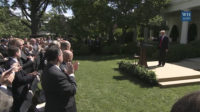On June 1, President Donald Trump fulfilled a campaign promise to withdraw from the Paris Agreement. The POTUS cited “onerous energy restrictions” and “draconian financial and economic burdens” of the international climate accord, which aims to mitigate global warming. He went on to affirm that under his administration, the country “will be environmentally friendly, but we’re not going to put our businesses out of work and we’re not going to lose our jobs.”
The announcement set off a flurry of responses from governments and organizations around the world—including many in the design community. The American Institute of Architects (AIA) president Thomas Vonier expressed concern that the withdrawal would “put us behind our major global competitors” in a statement issued that afternoon. Vonier’s words were quickly endorsed by the Royal Architectural Institute of Canada and the International Union of Architects. The U.S. Green Building Council (USGBC) president and CEO Mahesh Ramanujam said in a statement that he was “deeply disappointed” with the news, while Royal Institute of British Architects president Jane Duncan condemned the move as “one of the most regressive decisions of our time.”
The Paris Agreement originated at COP21, the 21st Conference of the Parties to the United Nations Framework Convention on Climate Change, and went into effect on November 4, 2016. Signatories cannot leave the deal for four years, meaning the U.S. is committed through November 2020—the end of Trump’s current term. Still, many in the profession, including Vonier, argue that the announcement alone is damaging. “U.S. architects have truly been at the forefront of international efforts to address energy and climate issues,” he tells RECORD. “The decision to withdraw signals retreat; that hurts the image of the United States and, along with it, its architects.”
But concern has been tempered with optimism, stemming from confidence in the private sector, local governments, and design professionals to “lead the charge toward action,” says the USGBC’s Ramanujam. “The principles of the Paris Agreement will move forward, and we hope the administration will see the benefits of engagement over time.”
Collectively, the design community has been promoting sustainability for years, with initiatives like the 2030 Challenge and the AIA 2030 Commitment (for carbonneutral buildings), as well as longstanding certification programs like LEED. Shortly after Trump’s inauguration, the Chicago-based group Architects Advocate published an open letter to the President, signed by more than 120 firms in Illinois, on climate change and energy use. And just days after news of the Paris Agreement withdrawal, an online letter called “We Are Still In” drew signatures from more than 1,200 politicians, academics, and major corporations—including many from architecture, engineering, and construction—still committed to the accord’s principles.
Firms are also taking action on an individual basis. For example, Atelier Ten, which consults on building systems and lighting and environmental design, signed the “We Are Still In” letter and joined Architects Advocate, but also conducts an annual carbon audit and pays for their offsets as a company. Texas design firm Lake | Flato recently implemented a program that allows employees to apply for paid time “grants” to conduct research that advances sustainable design, while engineering company Thornton Tomasetti has established a “Green Champion” program, giving employees leadership roles in helping their offices meet sustainable operations standards.
As KieranTimberlake partner (and Obama appointee to the National Institute of Building Sciences) James Timberlake says, “The more architects come together on these issues, as a community and within our own firms, the more attention we can attract from our congressional representatives and, eventually, the administration.”






Post a comment to this article
Report Abusive Comment